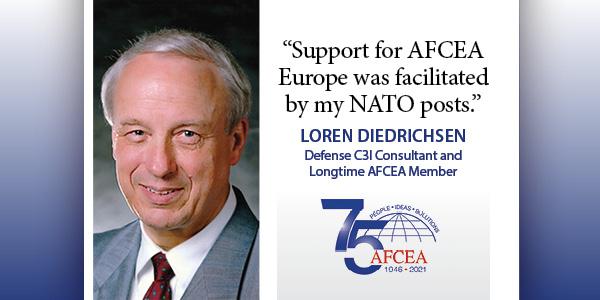AFCEA Europe Office Early Days
Editor’s Note: As AFCEA looks back on its long history, one of the pivotal decisions was to expand its reach more globally, which included formation of international chapters, creation of events in a variety of countries and establishment of an office in Brussels, Belgium, which would facilitate and grow European operations. Loren Diedrichsen had long seen the value of AFCEA in his work at Fort Monmouth and had been actively involved in that chapter. Upon accepting a post in Brussels, he combined his understanding of the AFCEA organization, his connections within NATO, and his knowledge of the technical community into a focus that would help AFCEA grow its European operations. Having an international office is a differentiator of AFCEA from many other defense associations, and the European office continues to add value to AFCEA by adding an international perspective to its mission. Diedrichsen shares his memories from his time helping AFCEA expand.
In 1984, Lt. General James M. Rockwell, USA, then the NATO Integrated Communications System Management Agency (NICSMA) deputy director general (who, as TRI-TAC director, was my boss) asked me to apply for the principal technical adviser post in NICSMA. My first response was not positive since I enjoyed my 27-year research and development career at Fort Monmouth, New Jersey, and future opportunities existed.
At Fort Monmouth, I was active in AFCEA serving in various posts, including chapter president and regional vice president. I also was involved in organizing/chairing the chapter symposia believing it essential to share unclassified information regarding projects, both planned and underway, with members of industry.
My only views of NATO had been obtained when serving as U.S. representative on National Experts Committee for NATO Communications Standards. Gen. Rockwell was persistent and convincing. During a follow-up call, I agreed to go for an interview and was offered the job.
When in Brussels for the principal technical advisor interview, I spoke with Maj. Gen. Tullio Baroni, ITA (Ret.), who was leading AFCEA European at the time. Since NICSMA and AFCEA Europe were located in a commercial building on Rue de Geneve, we agreed to meet in the building’s underground parking garage so he could escort me to his office. During discussions, he shared his vision for AFCEA Europe and expressed hope that I would join NATO, and as an AFCEAN volunteer, help him achieve his objectives. Our friendship began that day and grew over the years.
Before joining NATO, I met with Vice Admiral Jon Boyes, USN (Ret.), president of AFCEA International, at his request. He told me he knew I would remain active in AFCEA, but asked that I channel any AFCEA support I could provide toward helping Gen. Baroni achieve objectives of AFCEA Europe organization. (I had met Gen. Baroni at the home of a colleague, who befriended the general when both worked for NICSMA.)
When reporting to NICSMA in early July 1985, Gen. Baroni was the first person to welcome me. A few days later, we were in his office talking about AFCEA Europe and what I could do to help. One task was technical program director for the annual AFCEA Europe Symposium held in Brussels, and to organize similar symposia in European nations, both members and nonmembers of NATO. His vision was to work with nations to organize/conduct symposia. Gen. Baroni wanted to demonstrate that AFCEA and NATO were dedicated to a “world enjoying true peace and stability.” The first such symposium, held in Rome, was considered successful. Other symposia, or seminars, were held in London, Paris, Bonn, Madrid, Oslo, Warsaw, Prague and Copenhagen. The 1993 AFCEA Warsaw Seminar, “Evolution of Cost-Effective Communications and Information Processing Systems for a Changing World,” triggered a process of expanding AFCEA Europe activities in Eastern Europe.
After Gen. Baroni retired, I continued supporting AFCEA Europe Office; first under leadership of Maj. Gen. Emmanuel Greindl (Ret.), BEA and later Rear Adm. Sigurd Hess, GEN (Ret.)—who I knew at SHAPE. Special credit must go to Gen. Greindl, Pia Sementilli and Linda Guthrie for work in connection with AFCEA Europe’s expansion of the technical symposia program, establishment of chapters in Central and Eastern Europe, and outreach to PfP countries.
Support for AFCEA Europe was facilitated by my NATO posts, especially Supreme Headquarters Allied Powers Europe (SHAPE) Technical Center Director and NATO Consultation, Command and Control (C3) Agency general manager; close relationships with Supreme Allied Commander (SACEUR) (Gen. George Joulwan, USA, and Gen. Wesley Clark, USA) and SHAPE Staff; SHAPE Technical Center (STC) and NATO C3 Agency programs; rotational scientific team presence at Stabilaziation Force (SFOR) Headquarters; and relationships established with people (such as Poland’s Marek Amanowicz and Bulgaria’s Velizar Shalamanov). I would be remiss if I failed to credit excellent coverage by NATO’s Sixteen Nations & Partners for Peace magazine.
Fruits of Gen. Baroni’s vision were evident at 1999 NATO Summit when Poland, Czech Republic and Hungary became NATO members and at the Summit’s Exhibitions: “1999 Partnership for Peace Simulation Network Technology Options Demonstration,” which included product and capability demonstrations by nations (Sweden, Finland, France, United Kingdom, Germany, Netherlands, Czech Republic, Switzerland, Hungary, Ukraine, Bulgaria) and NATO bodies (Allied Command Europe, NC3A, Defense Academy Consortium). The centerpiece was NATO’s Distributed Computer Assisted Exercise Capability, featuring NATO Node operated by NC3A and national nodes operated in NATO and Partnership for Peace (PfP) nations.





Comments